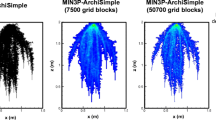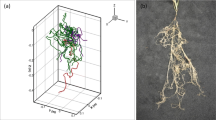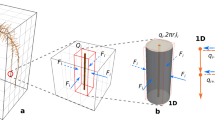Abstract
Several mathematical models have been developed to simulate processes and interactions in the plant rhizosphere. Most of these models are based on a rather simplified description of the soil chemistry and interactions of plant roots in the rhizosphere. In particular the feedback loops between exudation, water and solute uptake are mostly not considered, although their importance in the bioavailability of mineral elements for plants has been demonstrated. The aim of this work was to evaluate three existing coupled speciation-transport tools to model rhizosphere processes. In the field of hydrogeochemistry, such␣computational tools have been developed to␣describe acid–base and redox reactions, complexation and ion exchange, adsorption and precipitation of chemical species in soils and aquifers using thermodynamic and kinetic relationships. We implemented and tested a simple rhizosphere model with three geochemical computational tools (ORCHESTRA, MIN3P, and PHREEQC). The first step was an accuracy analysis of the different solution strategies by comparing the numerical results to the analytical solution of solute uptake (K or Ca) by a single cylindrical root. All models are able to reproduce the concentration profiles as well as the uptake flux. The relative error of the simulated concentration profile decreases with increasing distance from the root. The uptake flux was simulated for all codes with less than 5% error for K and less than 0.4% for Ca. The strength of the codes presented in this paper is that they can also be used to investigate more complex and coupled biogeochemical processes in rhizosphere models. This is shown exemplarily with simulations involving both exudation and uptake and the simultaneous uptake of solute and water.
Similar content being viewed by others
References
Allison JD, Brown DS, Novo-Gradac KJ (1991) MINTEQA2/PRODEFA2. A geochemical assessment model for environmental systems. Version 3.0, U.S. Environmental Protection Agency, Washington, DC, available at http://www.epa.gov/ceampubl/mmedia/minteq/index.htm
Appelo CAJ, Postma J (2005) Geochemistry, groundwater and pollution. A.A. Balkema, Leiden, pp 649
Barber SA (1995) Soil nutrient bioavailability: a mechanistic approach, 2nd edn. John Wiley & Sons, New York
Calba H, Cazevieille P, Jaillard B (1999) Modeling of the dynamics of Al and protons in the rhizosphere of maize cultivated in acid substrate. Plant Soil 209:57–69
Calba H, Firdaus, Cazevieille P, Thée C, Poss R, Jaillard B (2004) The dynamics of protons, aluminum, and calcium in the rhizosphere of maize cultivated in tropical acid soils: experimental study and modelling. Plant Soil 260:33–46
Calderhead A, Mayer KU (2004) Comparison of the suitability of the global implicit method and the sequential non-iterative approach for multicomponent reactive transport modelling. In: Proceedings of 5th Joint IAH-CNC/CGS Conference, Québec City, Québec, Canada, October 24–28, Session 6A:32–39
Geelhoed JS, Van Riemsdijk WH, Findenegg GR (1999) Simulation of the effect of citrate exudation from roots on the plant availability of phosphate adsorbed on goethite. Eur J Soil Sci 50:379–390
Gérard F, Tinsley M, Mayer KU (2004) Preferential flow revealed by hydrologic modeling based on predicted hydraulic properties. Soil Sci Soc Am J 68:1526–1538
Hiemstra T, Van Riemsdijk WH (1996) A surface structural approach to ion adsorption: the charge distribution (CD) model. J Colloid Interface Sci 179:488–508
Hiltner L (1904) Über neue Erfahrungen und Probleme auf dem Gebiet der Bodenbakteriologie unter besonderer BerÜcksichtigung der GrÜndÜngung und␣Brache. Arb Dtsch Landwirt Gesellschaft 98: 59– 78
Hinch EJ (1991) Perturbation methods. Cambridge University Press
Hinsinger P, Gobran GR, Gregory PJ, Wenzel WW (2005) Rhizosphere geometry and heterogeneity arising from root-mediated physical and chemical processes. New Phytol 168:293–303
Jacques D, Simunek J (2005) User manual of the multicomponent, variably-saturated flow and transport model HP1. Description, verification and Examples, Version 1.0. SCK·CEN, Belgium, SCK·CEN, BLG-988, 79 p
Keizer MG, van Riemsdijk WH (1995) ECOSAT, a computer program for the calculation of chemical speciation and transport in soil-water systems. Wageningen Agricultural University
Kirk GJD (1999) A model of phosphate solubilization by organic anion excretion from plant roots. Eur J Soil Sci 50:369–378
Mayer KU, Frind EO, Blowes DW (2002) Multicomponent reactive transport modeling in variably saturated porous media using a generalized formulation for kinetically controlled reactions. Water Resour Res 38:1174–1194
Meeussen JCL (2003) ORCHESTRA: an object-oriented framework for implementing chemical equilibrium models. Environ Sci Technol 37:1175–1182
Parker DR, Pedler JF (1997) Reevaluating the free-ion activity model of trace metal availability to higher plants. Plant Soil 196:223–228
Parkhurst DL, Appelo CAJ (1999) User’s guide to PHREEQC (version 2). A computer program for speciation, batch-reaction, one-dimensional transport, and inverse geochemical calculations. In: Water resources investigations report 99-4259. US Geological Survey, 312 pp
Roose T (2000) Mathematical model of plant nutrient uptake. Thesis, DPhil. Oxford University
Roose T, Fowler AC, Darrah PR (2001) A mathematical␣model of plant nutrient uptake. J Math Biol 42:347–360
Seuntjens P, Nowack B, Schulin R (2004) Root-zone modeling of heavy metal uptake and leaching in the presence of organic ligands. Plant Soil 265:61–73
Silberbush M, ben-Asher J, Ephrat JE (2005) A model for nutrient and water flow and their uptake by plants grown in a soilless culture. Plant Soil 271:309–319
Simunek J, Senja M, van Genuchten MT (1998) The HYDRUS-1D software package for simulating the one-dimensional movement of water, heat, and multiple solutes in variably-saturated media. Version 2.0. IGWMC-TPS-70. International Ground Water Modeling Center, Colorado School of Mines, CO, 202 p
Steefel CI, MacQuarrie KTB (1996) Approaches to modeling of reactive transport in porous media. Rev Mineral 34:83–129
Tinker PB, Nye PH (2000) Solute movement in the rhizosphere. Oxford University Press, New York
Unger AJA, Forsyth PA, Sudicky EA (1996) Variable spatial and temporal weighting schemes for use in multi-phase compositional problems. Adv Water Resour 19:1–27
Westall JC, Zachara JL, Morel FMM (1972) MINEQL, a computer program for the calculation of the chemical equilibrium composition of aqueous systems. Department of Civil Engineering, Massachusetts Institute of Technology Technical Note No. 18
Yeh GT, Tripathi VS (1989) A critical evaluation of recent developments in hydrogeochemical transport models of reactive multichemical components. Water Resour Res 25:93–108
Acknowledgements
This work profited from meetings and courses funded by the European Union within the framework of COST action 631 “Understanding and modeling plant–soil interactions in the rhizosphere environment”. The presented work is a collaborative effort of the working group “Models and databases of the rhizosphere including data transformation”. We would like to thank two anonymous reviewers for their comments that helped to improve the paper significantly.
Author information
Authors and Affiliations
Corresponding author
Additional information
An erratum to this article can be found at http://dx.doi.org/10.1007/s11104-007-9419-x
Rights and permissions
About this article
Cite this article
Nowack, B., Mayer, K.U., Oswald, S.E. et al. Verification and intercomparison of reactive transport codes to describe root-uptake. Plant Soil 285, 305–321 (2006). https://doi.org/10.1007/s11104-006-9017-3
Received:
Accepted:
Published:
Issue Date:
DOI: https://doi.org/10.1007/s11104-006-9017-3




